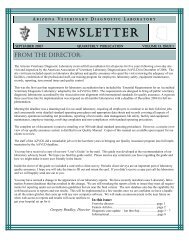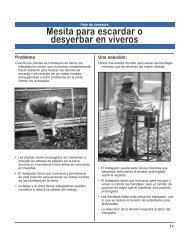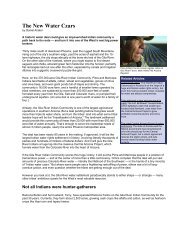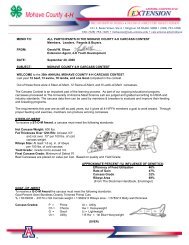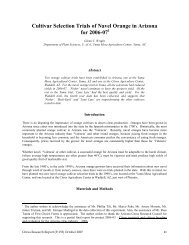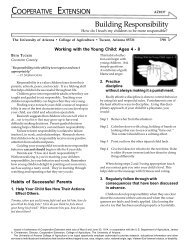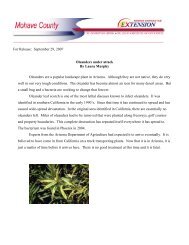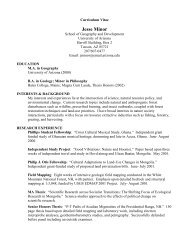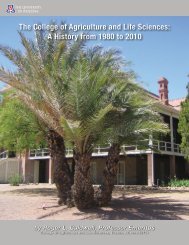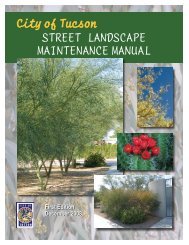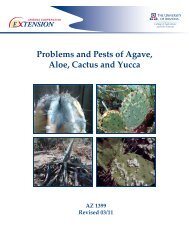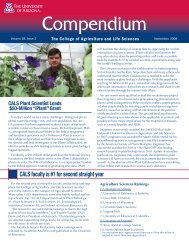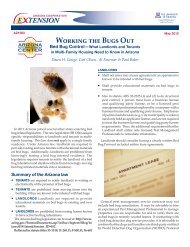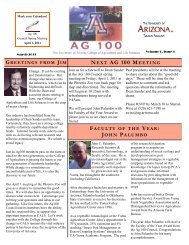Details - CALS Networking Lab - University of Arizona
Details - CALS Networking Lab - University of Arizona
Details - CALS Networking Lab - University of Arizona
Create successful ePaper yourself
Turn your PDF publications into a flip-book with our unique Google optimized e-Paper software.
Report Format and Data Organization<br />
Unlike others in the series, each taxonspecific<br />
chapter in this report has separate<br />
authorship. As such there are some differences<br />
in the organization and content <strong>of</strong> each chapter.<br />
Appendices related to each chapter are attributed<br />
to the respective author(s). We organized a single<br />
literature cited chapter at the end <strong>of</strong> the report.<br />
In the text, we report both common and<br />
scientific names for plants, and for vertebrates<br />
we report only common names (listed in<br />
phylogenetic sequence in tables) unless we<br />
reference a species that is not listed later in an<br />
appendix; in this case, we present both common<br />
and scientific names. For each taxonomic<br />
group we include an appendix <strong>of</strong> all species<br />
that we recorded in the district (Appendices<br />
A–D). In the amphibian and reptile and mammal<br />
chapters we review species that were likely<br />
or confirmed to have been present historically<br />
or that we suspect are currently present and<br />
may be recorded with additional survey effort.<br />
Scientific and common names used throughout<br />
this document are current according to accepted<br />
authorities for each taxonomic group: Integrated<br />
Taxonomic Information System (ITIS 2005) and<br />
the PLANTS database (USDA 2005) for plants;<br />
Stebbins (2003) for amphibians and reptiles;<br />
American Ornithologists’ Union (AOU 1998,<br />
2003) for birds; and Baker et al. (2003a) for<br />
mammals. We recognize that the designation <strong>of</strong><br />
a plant as “non-native” using the aforementioned<br />
lists may lead to the misclassification <strong>of</strong> some<br />
species, because these lists indicate only species<br />
status in North America as a whole, not regions<br />
within the continent. Therefore, our flora<br />
underestimates the number <strong>of</strong> non-native species,<br />
but because no authoritative list <strong>of</strong> non-native<br />
species exists for the region, we believe that use<br />
<strong>of</strong> these lists is justified.<br />
Spatial Data<br />
Most spatial data are geographically referenced<br />
to facilitate mapping <strong>of</strong> study plots and locations<br />
<strong>of</strong> plants or animals. Coordinates were stored<br />
in the Universal Transverse Mercator (UTM)<br />
projection (Zone 12), using the North American<br />
Datum <strong>of</strong> 1983 (NAD 83). We recorded UTM<br />
2<br />
coordinates using hand-held Garmin E-Map ®<br />
Global Positioning System (GPS) units (Garmin<br />
International Incorporated, Olathe, KS; horizontal<br />
accuracy approximately 10–30 m). We obtained<br />
some plot or station locations by using more<br />
accurate Trimble Pathfinder ® GPS units (Trimble<br />
Navigation Limited, Sunnyvale, CA; horizontal<br />
accuracy about 1 m). Although we map the<br />
locations <strong>of</strong> study plots, stations, or transects<br />
on Digital Orthophoto Quarter Quads (DOQQ;<br />
produced by the USGS), the locations <strong>of</strong> study<br />
areas will remain with the park and NPS Sonoran<br />
Desert Network I&M <strong>of</strong>fice in Tucson. We also<br />
produced distribution maps for all vertebrate<br />
species from this and other recent survey efforts<br />
(including wildlife observation cards at the<br />
park). Those maps will be archived in the same<br />
locations as the GPS coordinates.<br />
Species Conservation Designations<br />
We indicate species conservation designations by<br />
the following agencies: U.S. Fish and Wildlife<br />
Service (responsible for administering the<br />
Endangered Species Act), USDA Forest Service,<br />
<strong>Arizona</strong> Game and Fish Department, and Partners<br />
in Flight (a partnership <strong>of</strong> dozens <strong>of</strong> federal,<br />
state and local governments, non-governmental<br />
organizations, and private industry).<br />
Databases and Data Archiving<br />
We entered field data into taxon-specific<br />
databases (Micros<strong>of</strong>t Access version 97) and<br />
checked all data for transcription errors. From<br />
these databases, we reproduced copies <strong>of</strong> the<br />
original field datasheets using the “Report”<br />
function in Access. The output looks similar<br />
to the original datasheets but data are easier to<br />
read. The databases, printouts <strong>of</strong> field data, and<br />
other data such as digital photographs have been<br />
distributed to park staff and will be distributed to<br />
Special Collections at the <strong>University</strong> <strong>of</strong> <strong>Arizona</strong>.<br />
Original copies <strong>of</strong> all datasheets currently<br />
reside at the I&M <strong>of</strong>fice in Tucson and may be<br />
permanently archived at another location. Along<br />
with the archived data, we will include copies<br />
<strong>of</strong> the original datasheets and a guide to filling



